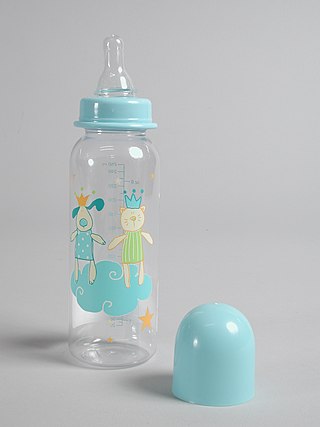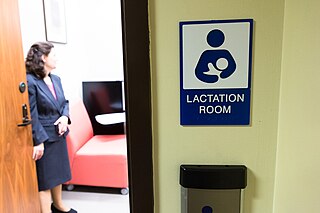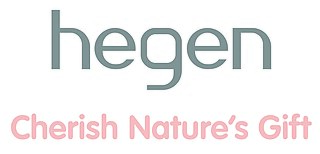
Infant formula, also called baby formula, simply formula, baby milk or infant milk, is designed and marketed for feeding to babies and infants under 12 months of age, usually prepared for bottle-feeding or cup-feeding from powder or liquid. The U.S. Federal Food, Drug, and Cosmetic Act (FFDCA) defines infant formula as "a food which purports to be or is represented for special dietary use solely as a food for infants by reason of its simulation of human milk or its suitability as a complete or partial substitute for human milk".

A baby bottle, nursing bottle, or feeding bottle is a bottle with a teat attached to it, which creates the ability to drink via suckling. It is typically used by infants and young children, or if someone cannot drink from a cup, for feeding oneself or being fed. It can also be used to feed non-human mammals.

A breast pump is a mechanical device that lactating women use to extract milk from their breasts. They may be manual devices powered by hand or foot movements or automatic devices powered by electricity.

Breast milk or mother's milk is milk produced by the mammary glands in the breast of human females. Breast milk is the primary source of nutrition for newborn infants, comprising fats, proteins, carbohydrates, and a varying composition of minerals and vitamins. Breast milk also contains substances that help protect an infant against infection and inflammation, such as symbiotic bacteria and other microorganisms and immunoglobulin A, whilst also contributing to the healthy development of the infant's immune system and gut microbiome.

Breast engorgement occurs in the mammary glands due to expansion and pressure exerted by the synthesis and storage of breast milk. It is also a main factor in altering the ability of the infant to latch-on. Engorgement changes the shape and curvature of the nipple region by making the breast inflexible, flat, hard, and swollen. The nipples on an engorged breast are flat or inverted. Sometimes it may lead to striae on nipples, mainly a preceding symptom of septation mastitis.
The International Code of Marketing of Breast-milk Substitutes is an international health policy framework for breastfeeding promotion adopted by the World Health Assembly (WHA) of the World Health Organization (WHO) in 1981. The Code was developed as a global public health strategy and recommends restrictions on the marketing of breast milk substitutes, such as infant formula, to ensure that mothers are not discouraged from breastfeeding and that substitutes are used safely if needed. The Code also covers ethical considerations and regulations for the marketing of feeding bottles and teats. A number of subsequent WHA resolutions have further clarified or extended certain provisions of the Code.

A supplemental nursing system (SNS), also known as a lactation aid, is a device that consists of a container and a capillary tube. It is used to provide additional nutrients to a baby whose mother has low milk supply. During breastfeeding, the end of the tube is placed alongside the mother's nipple so that both the tube and the breast are in the infant's mouth.
A human milk bank is "a service which collects, screens, processes, and dispenses by prescription human milk donated by nursing mothers who are not biologically related to the recipient infant". As of November 2019, there are 28 milk banks in North America that are members of the Human Milk Banking Association of North America (HMBANA). They are usually housed in hospitals, although some are free standing. Members of HMBANA follow the annually revised "Guidelines for the Establishment and Operation of a Donor Human Milk Bank" which include protocols for soliciting donors and collecting, processing, and distributing the milk. In addition, some states have required standards for donor human milk banks. However, the Food and Drug Administration (FDA), states that "the FDA has not been involved in establishing these voluntary guidelines or state standards." Some of these protocols are described below.

Erotic lactation is sexual arousal by breastfeeding on a woman's breast. Depending on the context, the practice can also be referred to as adult suckling, adult nursing, and adult breastfeeding. Practitioners sometimes refer to themselves as being in an adult nursing relationship (ANR). Two persons in an exclusive relationship can be called a nursing couple.

A lactation room is a private space where a nursing mother can use a breast pump. The development is mostly confined to the United States, which is unique among developed countries in providing minimal maternity leave. Historian Jill Lepore argues that the "non-bathroom lactation room" and breast pumps generally are driven by corporate need for workers rather than mothers' wishes or babies' needs.

Breastfeeding difficulties refers to problems that arise from breastfeeding, the feeding of an infant or young child with milk from a woman's breasts. Although babies have a sucking reflex that enables them to suck and swallow milk, and human breast milk is usually the best source of nourishment for human infants, there are circumstances under which breastfeeding can be problematic, or even in rare instances, contraindicated.

Breastfeeding, or nursing, is the process by which human breast milk is fed to a child. Breast milk may be from the breast, or may be pumped and fed to the infant. The World Health Organization (WHO) recommends that breastfeeding begin within the first hour of a baby's life and continue as often and as much as the baby wants. Health organizations, including the WHO, recommend breastfeeding exclusively for six months. This means that no other foods or drinks, other than vitamin D, are typically given. The WHO recommends exclusive breastfeeding for the first 6 months of life, followed by continued breastfeeding with appropriate complementary foods for up to 2 years and beyond. Of the 135 million babies born every year, only 42% are breastfed within the first hour of life, only 38% of mothers practice exclusive breastfeeding during the first six months, and 58% of mothers continue breastfeeding up to the age of two years and beyond.
Infant feeding is the practice of feeding infants. Breast milk provides the best nutrition when compared to infant formula. Infants are usually introduced to solid foods at around four to six months of age.

Foodborne illness is any illness resulting from the food spoilage of contaminated food, pathogenic bacteria, viruses, or parasites that contaminate food. Infant food safety is the identification of risky food handling practices and the prevention of illness in infants. Foodborne illness is a serious health issue, especially for babies and children. Infants and young children are particularly vulnerable to foodborne illness because their immune systems are not developed enough to fight off foodborne bacterial infections. In fact, 800,000 illnesses affect children under the age of 10 in the U.S. each year. Therefore, extra care should be taken when handling and preparing their food.
Nipple confusion is the tendency of an infant to unsuccessfully adapt between breast-feeding and bottle-feeding. It can happen when the infant is put back onto breast-feeding. Nipple confusion can turn into nipple refusal in which the infant refuses both the bottle and breastfeeding.
In breastfeeding women, low milk supply, also known as lactation insufficiency, insufficient milk syndrome, agalactia, agalactorrhea, hypogalactia or hypogalactorrhea, is the production of breast milk in daily volumes that do not fully meet the nutritional needs of her infant.
Nipple pain is a common symptom of pain at the nipple that occurs in women during breastfeeding after childbirth. The pain shows the highest intensity during the third to the seventh day postpartum and becomes most severe on the third day postpartum.

Establishment of breastfeeding refers to the initiation of providing breast milk of mother to baby. According to the World Health Organisation(WHO), breastfeeding is the best way to provide nourishment, including essential nutrients, energy and antibodies, to infants and toddlers. The start of breastfeeding is supported by the milk production which depends on the development of internal and external breast structure and hormonal control on milk secretion. Besides milk supply, adopting the correct approach of breastfeeding helps build up the maternal bond, which in turn promotes breastfeeding. Not only does nursing strengthen the mother-child relationship, but it also improves the intelligence and immunity of breastfed children and diminishes breastfeeding mothers' risks to have ovarian and breast cancer.

Hegen is a Singapore brand incorporated in June 2014 that designs and produces breastfeeding pumps, storage containers, and bottles. Its flagship product is its Express-Store-Feed system with the patented Press-to-Close, Twist-to-Open (PCTO) technology. Its current CEO is its founder, Yvon Bock. Hegen was reported to be one of the top 10 fastest growing companies in Singapore and ranked #41 in the Financial Times "High-Growth Companies Asia-Pacific 2022".

Hand expression of breast milk is a technique used by lactating mothers to express milk using their hands. It is an ancient practice that has been used by women across the world for centuries. Hand expression has gained renewed interest in recent years due to its affordability, portability, and effectiveness. It is an important tool for breastfeeding mothers, especially those who are unable to afford or access breast pumps.














